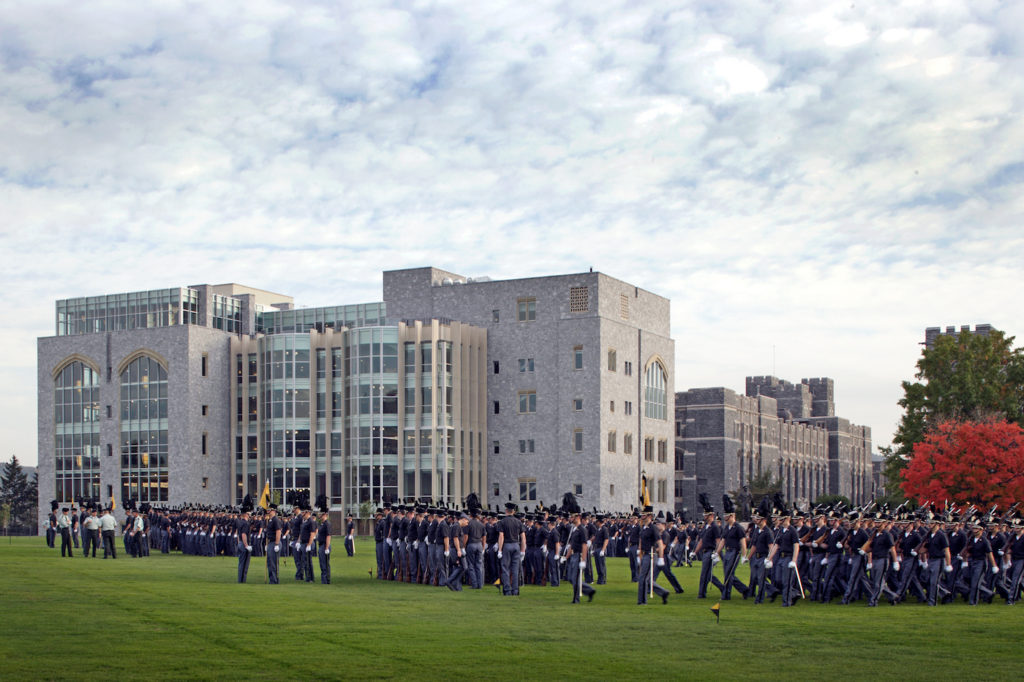In their provocative new book, The Coddling of the American Mind: How Good Intentions and Bad Ideas Are Setting up a Generation for Failure, Greg Lukianoff and Jonathan Haidt investigate the social trends that have contributed to a culture of “safetyism” on college campuses since 2013, such as institutional malfunction, declining trust, and a generation of young people motivated by socio-political causes. They offer intellectual tools to combat the perpetuation of what they consider to be the three Great Untruths: fragility, emotional reasoning, and an us versus them mentality between students and faculty.
Nestled in the Hudson River Valley in upstate New York, the United States Military Academy (USMA) at West Point is well known for its academic and physical rigor. USMA, which is the oldest of the five federal service academies, has precedents and procedures that help it to resist these three great untruths. Specifically, the liberal arts experience at West Point requires students (cadets) to seek out cognitive challenges, confront their implicit biases, and search for nuance in the understanding of leadership, morality, and selfless service. Devoted to the United States Army as a profession of arms, the military faculty and cadets can be considered allies in intellectual maturation. Much of the faculty and all of the cadets reside on a military base, and are practically sequestered from the stratification existing outside its walls.
The West Point community is unified by duty, honor, and country. In my experience as an Assistant Professor at West Point, the school’s homogeneous culture thwarts many of the contributing factors of coddling that Lukianoff and Haidt cite in their book. That makes it a useful case study—one that can offer important tools to combat coddling in academia more broadly.
How the West Point Uniform Uncoddles Minds
Start your day with Public Discourse
Sign up and get our daily essays sent straight to your inbox.The West Point classroom is guided by the famed Thayer method of instruction, an activity-based form of teaching where lecturing is discouraged. This approach requires cadets to take charge of their own learning. The classroom is transformed into a seminar where freedom of inquiry, diversity of thought, productive disagreement, and a sense of community flourish. Cadets are responsible for the content and synthesis of their ideas; faculty members are simply facilitators of thought. Shared interest in leadership and education facilitates a unique learning experience at West Point.
The students’ shared loyalty to their institution fosters collective goals for students. In addition, the military uniform reduces the impulse to classify people based solely on deeply rooted ideological schemas. Simply fostering an environment of aesthetic similarity can mitigate the three Great Untruths that Lukianoff and Haidt claim induce safetyism. Through the employment of rank and insignia, the cadet uniform functions as a sort of avatar. The uniform contributes to a hierarchy that organizes behavior while simultaneously cloaking individuality and transforming students into cadets. Coddling the mind is difficult when ideas are discussed within the strict meritocracy that the uniform illustrates.
Lukianoff and Haidt also address intersectionality as a theory that promotes tribalism on college campuses. It is a term widely found in campus activism and one that examines how power relationships are intertwined and mutually constructing. The problem here is divergent interpretations of intersectionality that lead to assumptions about race, class, gender, and oppression. In other words, the us vs. them untruth may be motivated by suppositions that conclude, for example, that all black people are oppressed, or the belief that all white people enjoy a position atop the social hierarchy. Here again, the uniform acts as an equalizer. When everyone looks the same, people are likely to be more accepting of divergent worldviews. Cadets demonstrate this in discourse at West Point as they challenge one another to substantiate their ideas based on logic.
The uniform as a tool, replete with rank and insignia, also communicates credibility and power. In many ways, a classroom full of uniformed students is impervious to social ills of society writ large. A way to foster students’ critical consciousness of these ills is to expose them to diverse cultures and ideas through literature. The careful selection and instruction of thoughtful texts facilitate the critical negotiation of perspectives that cadets will likely never experience, but that may be held by people they lead. The literature classroom at West Point serves as a public arena for considering and discussing strongly contested ideas and issues. The faculty prompt students to respect divergent worldviews and consider the possibility of tribalism as an instinct.
Teaching Black Literature to Military Cadets
I have found that teaching black literature in the meritocracy confronts intersectionality and, if done effectively, counters insularity. Cadets are able to identify their knowledge gaps and biases, intervene in the perpetuation of dubious ideology toward malignant ends, and interrogate their peers to understand the value of different perspectives. All of these ends thwart the emergence of Lukianoff and Haidt’s three untruths.
In the spring semester of 2018, given the delicate atmosphere surrounding the events in Charlottesville, Virginia, I assigned my literature classes the provocative memoir by author Ta-Nehisi Coates. The book, Between the World and Me, illustrates a unique perspective of nationalism while challenging conventional perspectives regarding American history and patriotism.
I employed the Thayer method to prompt cadets to consider Coates’s worldview. To do so, the class analyzed the music referenced in Coates’s book, tackled the colloquialisms mentioned, and, when Coates visited West Point, discussed the West Point honor code alongside aspects of mythologized Civil War history—chattel slavery being the germ of that discussion.
During instruction, to launch my cadets into discomfort, I wrote the word nigger on the chalkboard and asked my students to interrogate the term. After about a minute of very uncomfortable silence, interpretations rang out. There was no dissent. Young people are curious, though many lack the language to productively engage in discourse concerning tough issues. In many schools, this act would surely get educators in trouble. The n-word is sensitive and powerful, but it also contains explanations that explain contemporary division.
My classes and I spent the time talking about the colloquial use and history of that term. We also talked about attempts to appropriate the term in our contemporary lexicon. The demographic composition of my class is typical of many predominantly white institutions (PWIs). Alongside myself, there were maybe two other people of color in each of my four literature sections that semester. I spent a portion of that lesson contextualizing the term and the social implications of it, with respect to etymology, double consciousness, and themes of identity.
The theme of my literature courses revolves around identity and language. These focal areas require thoughtfulness to understand the many emotional and ethical struggles that coincide with military experience. Coddling only does a disservice to my students, many of whom might deploy to areas of conflict after they graduate. A pedagogy of discomfort allows cadets to nurture their bias toward the goal of providing quality leadership to those future soldiers who may very well live many of the experiences we read about.
For those willing to think deeply about the un-coddling of the American mind, the factor of fostering a sense of shared identity is paramount. West Point is unlike most colleges and universities largely because of its ability to foster collective identity. Educators must not be afraid to take risks as they develop their students into productive American citizens. Administrators must support educators, helping to create a learning environment that asks its students to accept responsibility for their own learning.
The fact that West Point is a military academy need not negate its pedagogical method as a valid model for a productive learning environment. If we view our students as future contributing citizens and leaders, then our investment in them is an investment in our culture as a whole. The Great Untruths—fragility, emotional reasoning, and an us versus them mentality—exist largely because academic institutions tolerate them.













